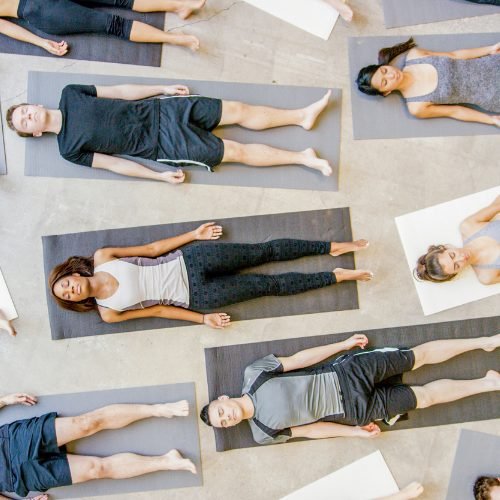Holotropic breathwork, often abbreviated as HB, is a transformative practice centered around manipulating breathing patterns to influence one’s mental, emotional, and physical states. Originally rooted in spiritual traditions, it has evolved into a trademarked activity gaining popularity among individuals seeking a distinctive pathway to self-healing and holistic well-being.
During holotropic breathwork, participants breathe rapidly and evenly to induce an altered state from which it is believed to gain a deeper understanding of oneself. Some describe this experience as an intense form of meditation.
Introduced in the 1970s by psychiatrists Stanislav and Christina Grof, holotropic breathwork emerged as a method to induce altered states of consciousness without the use of drugs, offering a potential therapeutic avenue. While it originated within a therapeutic framework, it has also been embraced globally as a spiritual practice, with many participants engaging to expand consciousness rather than solely addressing mental health concerns.
Advocates of holotropic breathing often propose that it facilitates a progression towards heightened awareness and deeper understanding. For individuals feeling stagnant or unable to progress through conventional methods, the allure lies in the possibility of transcending into alternative states of being. This transformative journey frequently involves experiences of catharsis, leading to a sense of awakening and personal growth.
History of Holotropic Breathing
After LSD became illegal in the late 1960s, the Grofs, who had been proponents of the therapeutic effects of LSD, developed holotropic breathwork.
It was created to achieve psychedelic-like states without using psychedelic drugs. The Grofs were trained in Freudian psychoanalytic therapy and believed the process of deep, self-exploration brought on by these altered states create healing.
Stanislav Grof is the co-founder of transpersonal psychology (along with Abraham Maslow). Grof began his work at the Psychiatric Research Institute in Prague and eventually moved to Johns Hopkins University in Baltimore. His work was conducted with patients experiencing psychiatric illness, cancer, and drug addiction.
How does it work?
Holotropic breathwork operates by employing a controlled breathing technique to access altered states of consciousness, aiming towards enlightenment or a sense of holistic wellness. Derived from the Greek words “holos” (whole) and “trepein” (to move toward), “holotropic” signifies a journey towards wholeness.
Central to this approach is the principle that healing originates from within the individual engaging in the breathwork. It is designed to foster a sense of personal empowerment in participants. Notably, the belief underpinning this practice is that any emergence of trauma during a session is deemed necessary for healing purposes, with such revelations not predetermined at the outset of the session.
Each individual’s encounter with holotropic breathwork is characterized by uniqueness, self-guidance, and an unfolding process as the practice unfolds. This self-directed nature allows for a deeply personal and transformative experience tailored to the individual’s needs and journey towards wholeness. Each person has an inner radar that can determine the most important experience at a given moment, but we cannot be aware of this experience until it happens.
People often experience an intense, “therapeutic” crisis that helps flush negative energies away and leads them to a place of greater understanding and healing. This will always be specific to the person at that particular time in their life.
Can Holotropic Breathwork be risky
Holotropic breathing can cause reduced carbon dioxide and other alterations in blood chemistry that can lead to medical hyper ventilating, dizziness, fainting, weakness, spasms of the hands and feet, and even seizures.
The can evoke intense physical and emotional changes. For anyone considering trying holotropic breathing, it is a good idea to discuss risks with your healthcare provider, especially if you have any of the following conditions:
- Cardiovascular disease
- Heart attacks, high blood pressure, and angina
- Glaucoma or retinal detachment
- Recent injury or surgery
- Any condition that requires you to take medication
- Panic attacks or psychosis
- Seizures
- Severe mental illness
- Aneurysms (or family history)
- You are pregnant or are breastfeeding
How is it done?

Holotropic breathwork is commonly practiced within a group setting under the guidance of a trained facilitator, although it can also be offered individually or as part of a retreat. In a group session, participants are paired off into “breathers” and “sitters,” where the breather actively engages in the practice while the sitter ensures their safety and support.
During a session, the facilitator directs the breather to increase the speed and depth of their breathing, encouraging a rhythmic and even pattern to prevent complications from hyperventilation. Sessions typically last 2 to 3 hours, during which the breather lies on a mat to facilitate free movement according to their breath’s rhythm.
Repetitive music, starting with drumming and transitioning to “heart music” and eventually meditative tunes, is played to aid in inducing altered states of consciousness akin to vivid dreams. Participants are encouraged to make any sounds or movements that feel natural to them.
The session remains open-ended, allowing participants to derive their own meaning and engage in self-discovery. Afterward, participants may create mandalas to reflect on their experiences, which can range from re-experiencing past trauma to developing spiritual awareness. The aim is for holotropic breathwork to serve as a catalyst for addressing personal issues and fostering growth.
Breathers and sitters may swap roles in subsequent sessions, and there are no specific guidelines or expectations regarding the issues explored during a session, leaving participants free to address whatever arises during their altered state of consciousness.
How holotropic breathwork feels
Participating in holotropic breathwork can evoke a range of sensations and experiences. While the idea of rapid breathing might initially seem daunting, practitioners are reassured that they can adjust their pace or pause if the sensations become overwhelming. However, there’s an encouragement for participants to persist (safely) through any discomfort, as it’s believed to be a pathway towards the enlightenment sought in the practice.
Instead of labeling it as an “altered state of consciousness,” some prefer the term “non-ordinary state of consciousness” to avoid negative associations. This state can be likened to having a vivid dream, where the mind transcends ordinary perceptions and dives into deeper layers of awareness and insight.



